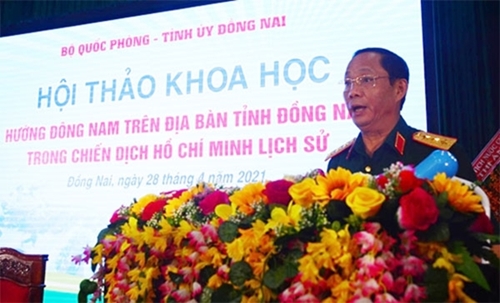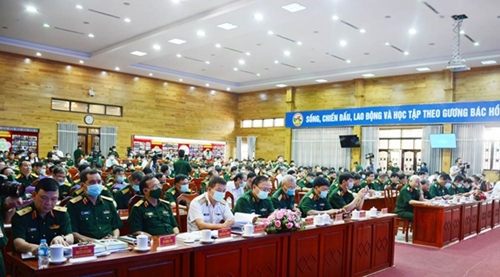This was part of a program of the Ministry of National Defense to celebrate the 46th anniversary of the liberation of the South and national reunification (April 30, 1975).
The event was co-chaired by Senior Lieutenant General Nguyen Tan Cuong, Deputy Minister of National Defense and Co-head of the Seminar Steering Committee; Nguyen Phu Cuong, Secretary of the Dong Nai Provincial Party Committee, Chairman of the Provincial People's Council, Co-head of the Seminar Steering Committee; Senior Lieutenant General Tran Quang Phuong, Deputy Director of the General Department of Politics, Deputy Head of the Seminar Steering Committee, as well as Chairman of Dong Nai Provincial People's Committee Cao Tien Dung, Deputy Commander of Military Region 7 Major General Du Truong Giang, Commander of Army Corps 2 Major General Pham Van Hoa, Director of the Vietnam Military History Institute Major General Nguyen Hoang Nhien.
Present at the seminar were also former Chairman of the General Department of Politics Senior Lieutenant General Pham Thanh Ngan, Deputy Head of the Party Central Committee’s Commission for Mass Mobilization Nguyen Hong Linh, as well as representatives of departments, ministries, central branches, defense agencies, military units, general-ranks, historical witnesses, and domestic and international scientists.
Highlighting the sound leadership and proper policies of the Party
Speaking at the opening of the seminar, Senior Lieutenant General Nguyen Tan Cuong emphasized, in the last days of April 1975, Army Corps 2 was assigned to fighting the enemy in Dong Nai, southeast of Saigon - one of the five directions of attack in the Ho Chi Minh Campaign. Army Corps 2 was one of the units that opened fire to begin the Ho Chi Minh Campaign. Along with local armed forces and people, units of Army Corps 2 engaged in fierce battles against the enemy in southeastern Saigon. They smashed the enemy's southeastern perimeter defensive line, facilitating our general uprising and offensive on the center of Saigon – the hideout of the U.S.’s henchman government, to completely liberate the South and reunite the country.
    |
 |
|
Sr. Lt. Gen. Nguyen Tan Cuong speaks at the event. |
The victory in the southeastern direction of attack shows the strength of synergistic combat and close, effective coordination among revolutionary forces, namely the people and armed forces of Dong Nai province and regular military units of Army Corps 2. It also affirms the important position and significant contribution of our forces in the southeast direction in the Ho Chi Minh Campaign.
Highlighting major subjects of the seminar, Senior Lieutenant General Tran Quang Phuong suggested delegates, scientists and historical witnesses analyze and clarify the circumstance in South Vietnam prior to the historic Ho Chi Minh Campaign; situational developments in favor of the revolutionary side; the enemy’s situation; the strategic vision, right policy and sound leadership of the Politburo and the Central Military Commission; the smart direction, and excellent command and control of the campaign from strategic staff agencies under the Ministry of National Defense. General Phuong also requested former commanders and scientists to explain the situation of the revolutionary forces; Southern people and armed forces’ preparations for the Ho Chi Minh Campaign, force organization and the position of the revolutionary forces, including local forces and Army Corps 2, in southeastern Saigon.
In his speech, Major General Nguyen Duc Huy, former Deputy Commander of Division 325 (Army Corps 2), former Acting Commander of Military Region 2 and one of the historical witnesses, underlined, “To ensure the victory of the Ho Chi Minh Campaign, the Party Central Committee mobilized four army corps and Grouping 232 (equivalent to an army corps) along with the local military units and local people. The Politburo and the Central Committee of the Party set requirements and assigned specific tasks to the forces undertaking each direction of attack. The Politburo and the Party Central Committee also instructed the Defense Ministry to focus forces on the east and southeast of Saigon to destroy the enemy’s important targets in the southeastern provinces of Long Khanh and Ba Ria - Vung Tau before tightening siege around Saigon city. Following higher-level instructions, the Ho Chi Minh Campaign Command assigned Army Corps 2 to attacking from the southeastern direction. Alongside the local forces, Army Corps 2 successfully accomplished its assignment, contributing significantly to the great victory of the Ho Chi Minh Campaign.
    |
 |
|
Sr. Lt. Gen. Tran Quang Phuong addresses the event. |
Assoc. Prof., Dr. Ha Minh Hong (University of Social Sciences and Humanities of Ho Chi Minh City) emphasized that, among the five especially important targets that must be conquered, the Independence Palace was the most important. Our forces in all five directions of attack on Saigon completed the combat plans on April 30, 1975. Army Corps 2 from the southeast was the first to enter Saigon and took the Independence Palace.
Lessons about the coordination of forces
Reports at the seminar underlined, in people's warfare, regular military units will never separate from local armed forces and people. To clarify the thesis, Head of the Education and Information Commission of the Dong Nai Provincial Party Committee Pham Xuan Ha stated, “The Party Committee, the local army and people of Dong Nai with the spirit of self-reliance actively conducted people's warfare and coordinated with Army Corps 2 in fighting and capturing the enemy’s Nuoc Trong base, Armored School, Infantry School, Long Binh warehouse, and Long Thanh Military Sub-command. Especially, local people actively mobilized enemy troops to turn to the revolutionary side, rose up to take over the local governments from the U.S. henchmen, and provided human and material support for armed forces to combat enemy military troops.”
Senior Colonel Vu Van Dien, Chief of the Dong Nai provincial Military Command, shared a similar view, saying that to pave the way for a contingent of Army Corps 2 to jab deep into the enemy’s den in Saigon city, the armed forces of Bien Hoa were assigned to fighting the enemy and controlling the route, particularly bridges, leading to central Saigon. Meanwhile, the local people and armed forces rose up and seized power, creating more motive power for the regular army to fight the enemy in southeast Saigon.
Senior Colonel Nguyen Van Thuat, Deputy Commander of the Armored Corps, stated, “The effective coordination among forces was evidently demonstrated in a number of battles. Thanks to the effective coordination and support of ground infantry units, Tank Brigade 203 (Army Corps 2) defeated enemy garrisons in Nuoc Trong base, at Thai junction, and at the commando airfield. Meanwhile, the local armed forces protected bridges and roads for Army Corps 2 to quickly maneuver into Saigon city as planned. In particular, local people transported nearly one division of Army Corps 2 across the river under fierce enemy bombardment.
    |
 |
|
Participants of the seminar |
Applying and promoting historical and traditional values
During discussions, delegates highlighted academic and practical values of scientific studies and reports delivered at the seminar. They all agreed that research of battles in the past war is needed as lessons from the old battles can be applied to military training for cadets at military schools and troops of military units.
From the perspective of a military expert, Assoc. Prof., Dr., Lieutenant General Nguyen Ngoc Ca, Rector of the Army Officers Training School No.2, affirmed that lessons drawn from the past battles will help the school improve the contents of its training programs for officers and cadets, contributing to building a modernized military by 2030 according to the Resolution of the 13th National Party Congress.
Concluding the seminar, Senior Lieutenant General Nguyen Tan Cuong highly appreciated the scientific findings of presentations and fruitful results of discussions at the seminar, saying that the organizing panel of the seminar received more than 80 reports from high-ranking military and civilian officials, scientists and historical witnesses who engaged in the war.
He affirmed that the reports at the seminar are valuable documents for historians, researchers, military people and people from all walks of life to learn more about the historical Ho Chi Minh Campaign, particularly details of battles in southeastern Saigon in April 1975.
General Cuong noted that the seminar has elicited national pride and patriotism while lessons drawn from the Ho Chi Minh Campaign and battles in southeast Saigon have contributed importantly to the cause of building and firmly defending the Socialist Vietnam Fatherland and building the Vietnam People’s Army into a modernized military by 2030.
Translated by Thu Nguyen